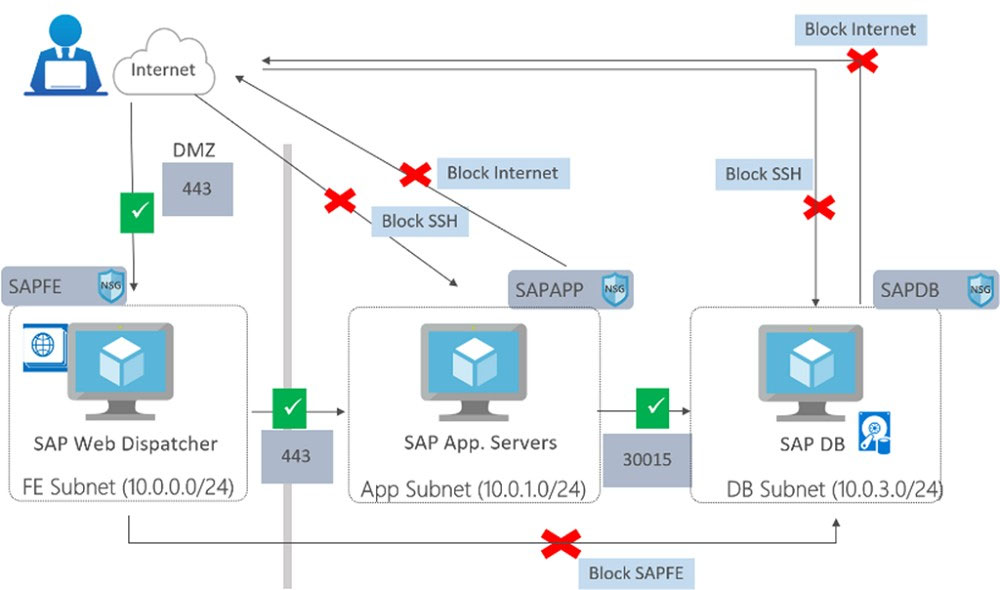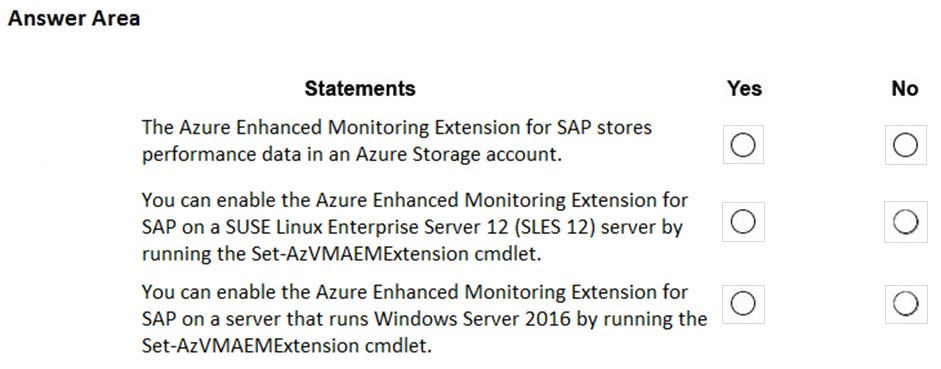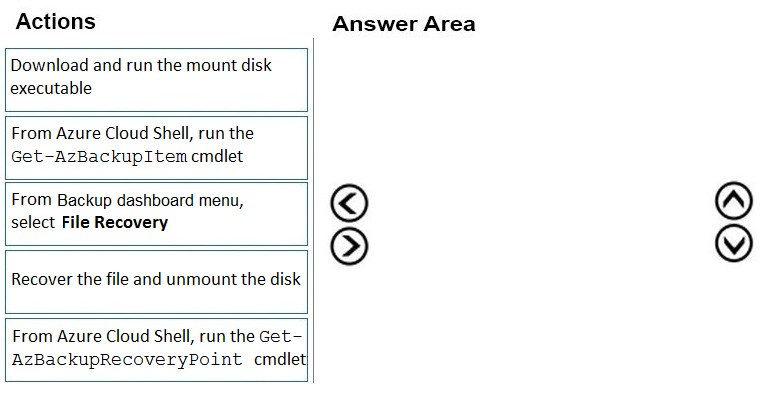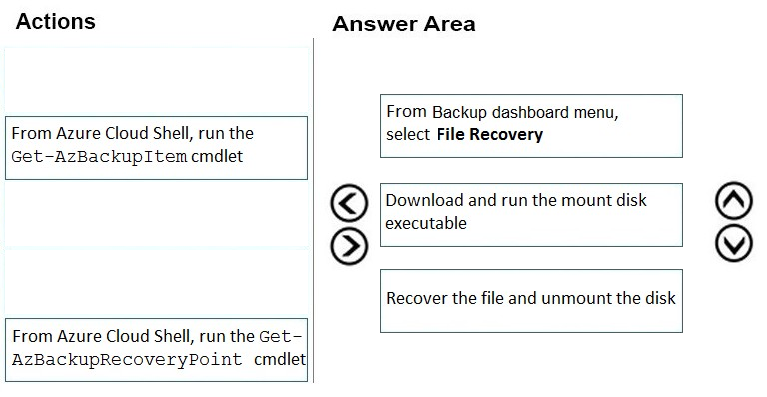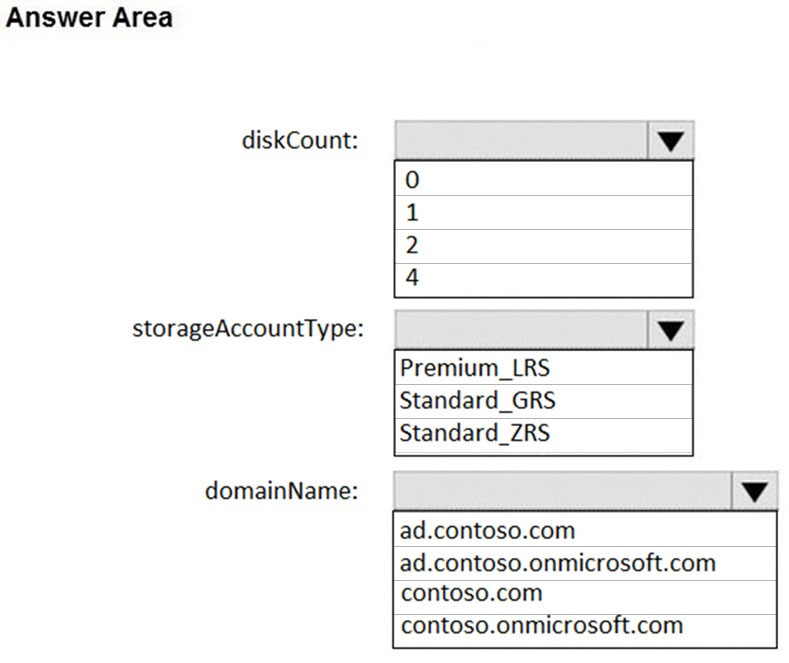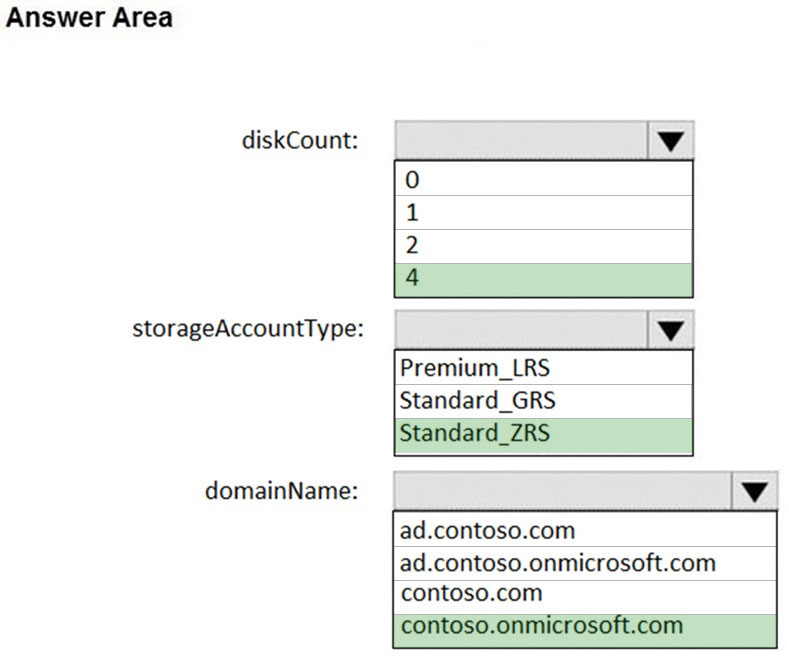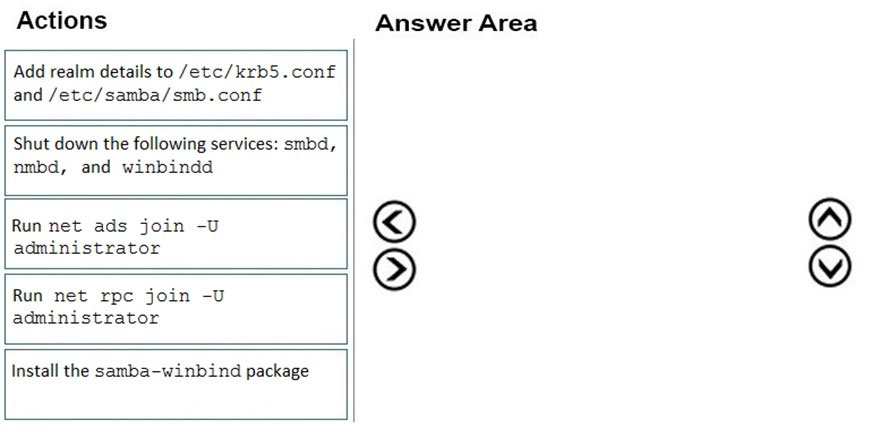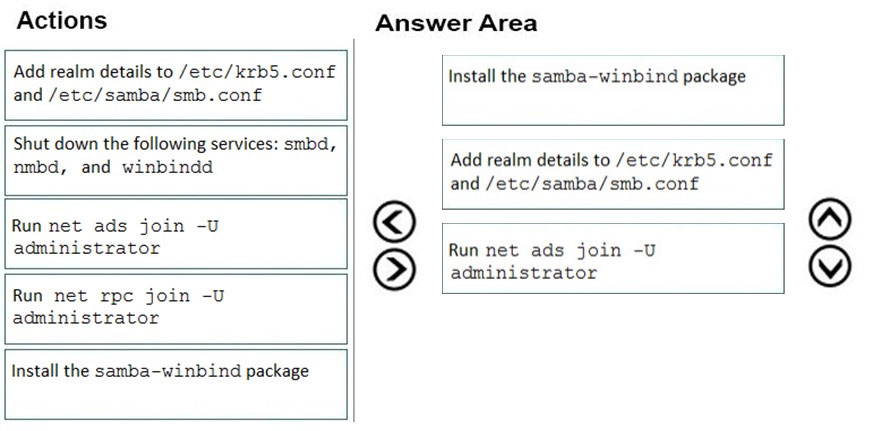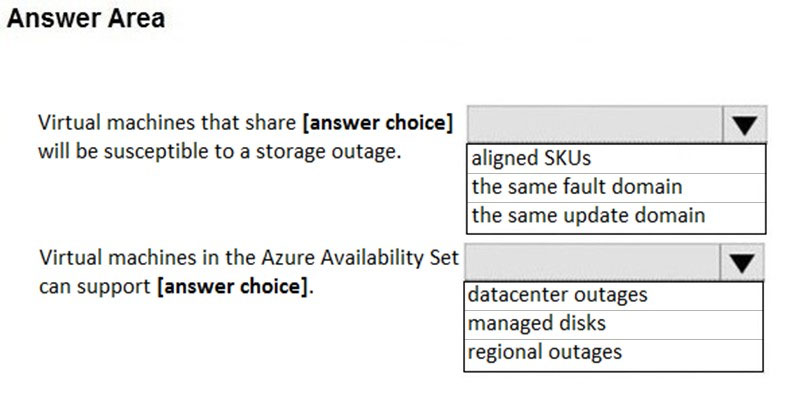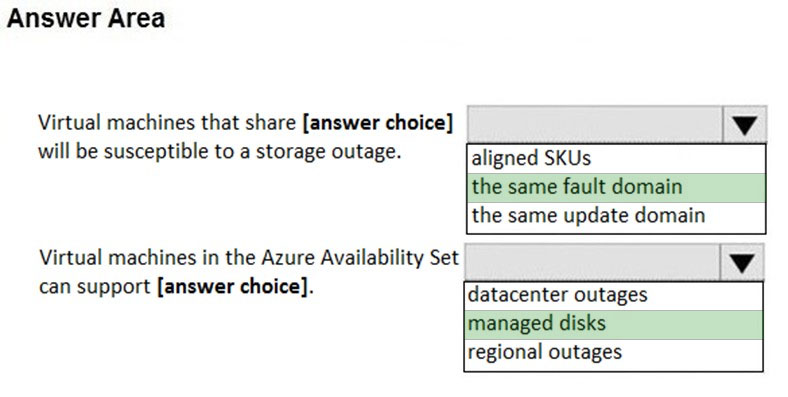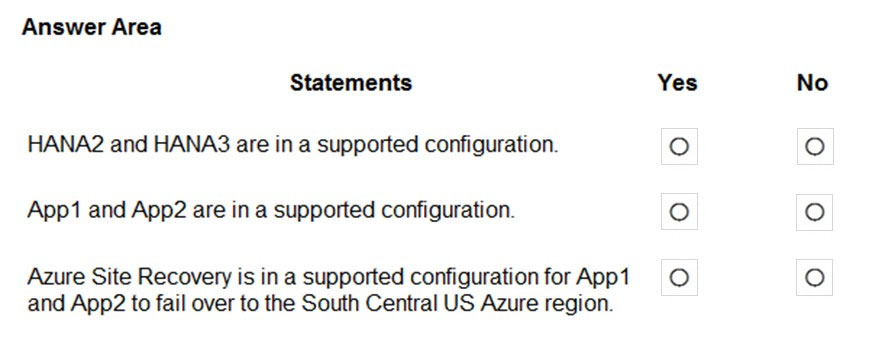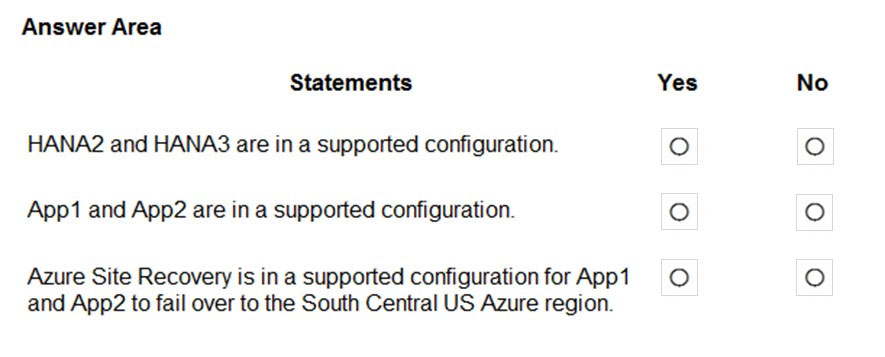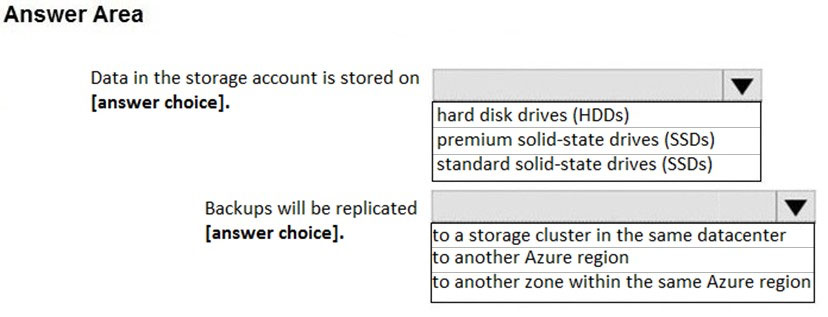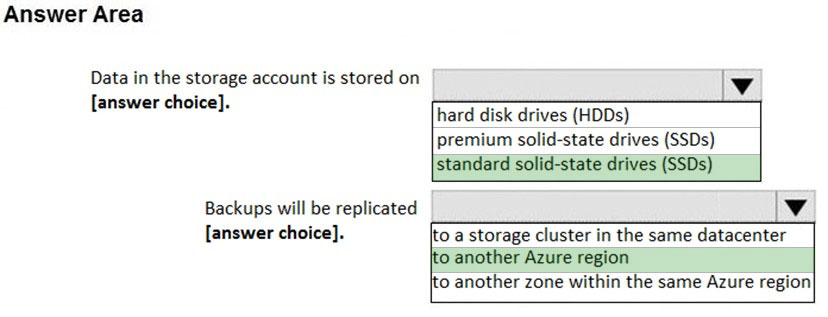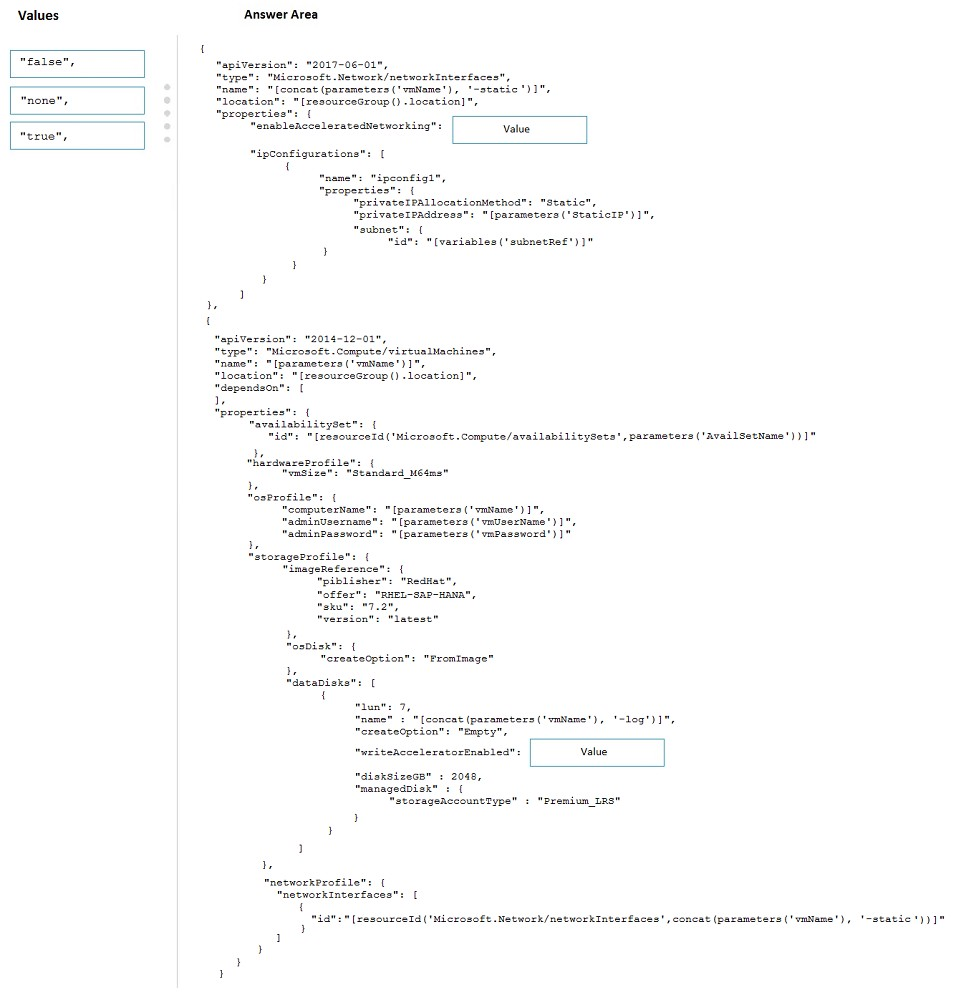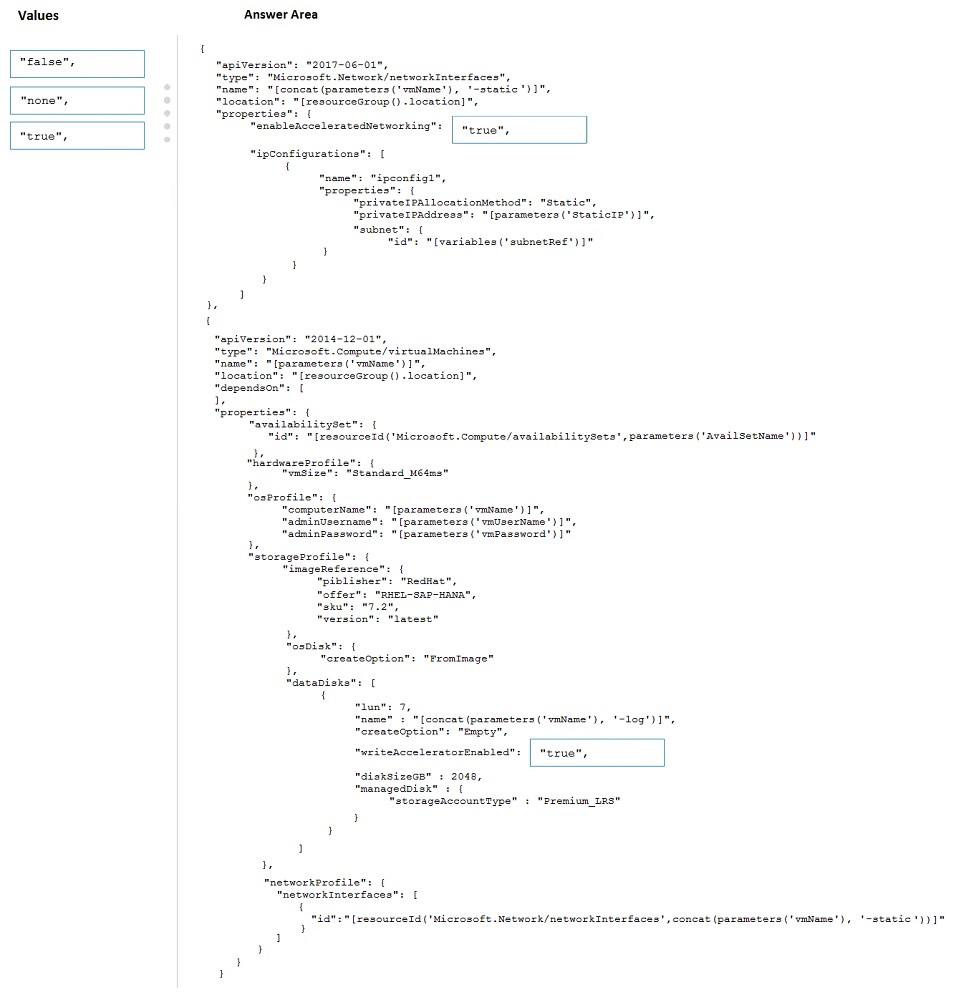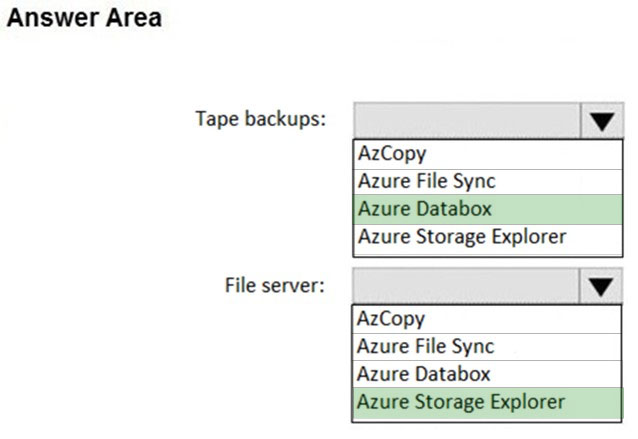AZ-120 Practice Test Free – 50 Real Exam Questions to Boost Your Confidence
Preparing for the AZ-120 exam? Start with our AZ-120 Practice Test Free – a set of 50 high-quality, exam-style questions crafted to help you assess your knowledge and improve your chances of passing on the first try.
Taking a AZ-120 practice test free is one of the smartest ways to:
- Get familiar with the real exam format and question types
- Evaluate your strengths and spot knowledge gaps
- Gain the confidence you need to succeed on exam day
Below, you will find 50 free AZ-120 practice questions to help you prepare for the exam. These questions are designed to reflect the real exam structure and difficulty level. You can click on each Question to explore the details.
You have an SAP production landscape in Azure that contains an SAP HANA database. You need to configure a Recovery Services vault that will be used to back up the HANA database server. The solution must ensure that the virtual machine and the HANA database can be restored manually to a paired region. What should you do first?
A. Create a Recovery Services vault in the paired region.
B. Enable Cross Region Restore.
C. Configure zone-redundant storage (ZRS) replication for the storage.
D. Create a recovery plan.
HOTSPOT - You have an instance of SAP HANA on Azure (Large Instances) named HLI1. You plan to deploy Azure virtual machines. The virtual machines will host application servers that will access the database on HLI1. You need to minimize latency between the application servers and HLI1. What should you do? To answer, select the appropriate options in the answer area. NOTE: Each correct selection is worth one point.
You have an Azure subscription. Your company has an SAP environment that runs on SUSE Linux Enterprise Server (SLES) servers and SAP HANA. The environment has a primary site and a disaster recovery site. Disaster recovery is based on SAP HANA system replication. The SAP ERP environment is 4 TB and has a projected growth of 5% per month. The company has an uptime Service Level Agreement (SLA) of 99.99%, a maximum recovery time objective (RTO) of four hours, and a recovery point objective (RPO) of 10 minutes. You plan to migrate to Azure. You need to design an SAP landscape for the company. Which options meet the company's requirements? A. ✑ Azure virtual machines and SLES for SAP application servers ✑ SAP HANA on Azure (Large Instances) that uses SAP HANA system replication for high availability and disaster recovery B. ✑ ASCS/ERS and SLES clustering that uses the Pacemaker fence agent ✑ SAP application servers deployed to an Azure Availability Zone ✑ SAP HANA on Azure (Large Instances) that uses SAP HANA system replication for database high availability and disaster recovery C. ✑ SAP application instances deployed to an Azure Availability Set ✑ SAP HANA on Azure (Large Instances) that uses SAP HANA system replication for database high availability and disaster recovery D. ✑ ASCS/ERS and SLES clustering that uses the Azure fence agent SAP application servers deployed to an Azure Availability Set✑ SAP HANA on Azure (Large Instances) that uses SAP HANA system replication for database high availability and disaster recovery
After you answer a question in this section, you will NOT be able to return to it. As a result, these questions will not appear in the review screen. You have a complex SAP environment that has both ABAP- and Java-based systems. The current on-premises landscapes are based on SAP NetWeaver 7.0 (Unicode and Non-Unicode) running on Windows Server and Microsoft SQL Server. You need to migrate the SAP environment to a HANA-certified Azure environment. Solution: You deploy a new environment to Azure that uses SAP NetWeaver 7.4. You export the databases from the on-premises environment, and then you import the databases into the Azure environment. Does this meet the goal?
A. Yes
B. No
You have an Azure subscription. You deploy Active Directory domain controllers to Azure virtual machines. You plan to deploy Azure for SAP workloads. You plan to segregate the domain controllers from the SAP systems by using different virtual networks. You need to recommend a solution to connect the virtual networks. The solution must minimize costs. What should you recommend?
A. a site-to-site VPN
B. virtual network peering
C. user-defined routing
D. ExpressRoute
You have a two-node SAP HANA cluster that is hosted on Azure virtual machines. Each cluster node uses Azure NetApp Files to store database files. The nodes replicate synchronously by using HANA system replication. You need to implement a backup solution for the HANA databases. The solution must meet the following requirements: • Be cluster aware. • Support the use of snapshots. • Ensure that backups are application consistent. What should you include in the solution?
A. AzAcSnap
B. the Az.NetAppFiles PowerShell module
C. Microsoft Azure Backup Server (MABS)
D. the azure_hana_backup command
You plan to deploy a highly available SAP HANA system in a scale-out configuration with standby to Azure virtual machines. You need to implement shared storage volumes by using Azure NetApp Files. What should you create first?
A. a service endpoint
B. a private link
C. a delegated subnet
D. a private endpoint
You have an Azure subscription. You plan to deploy a virtual machine named VM1 that will have the following configurations: • Data disk size: 4 TB • Generation: Generation 2 • Data disk type: Ultra disk • Data disk encryption type: Double encryption VM1 will host the SAP global transport directory in a volume on the data disk. You need to ensure that you can replicate VM1 by using Azure Site Recovery. Which configuration should you change?
A. generation
B. data disk type
C. data disk encryption type
D. data disk size
You have an SAP production landscape on Azure that uses a two-node Pacemaker cluster. You need to ensure that the cluster automatically fails over for Azure scheduled events. What should you configure on each node?
A. the Azure Monitor agent
B. the Linux diagnostics extension (LAD)
C. the Azure fence agent
D. the Azure VM extension for SAP
You have an SAP landscape that is hosted on VMWare. You plan to migrate an existing SAP landscape to Azure by using Azure Migrate. You need to configure firewall rules to allow access to the Azure Migrate appliance management app. To which port should you provide access?
A. 3900
B. 44368
C. 44400
D. 50014
HOTSPOT - For each of the following statements, select Yes if the statement is true. Otherwise, select No. NOTE: Each correct selection is worth one point.
DRAG DROP - You have an on-premises network and an Azure subscription. You plan to deploy a standard three-tier SAP architecture to a new Azure virtual network. You need to configure network isolation for the virtual network. The solution must meet the following requirements: • Allow client access from the on-premises network to the presentation servers. • Only allow the application servers to communicate with the database servers. • Only allow the presentation servers to access the application servers. • Block all other inbound traffic. What is the minimum number of network security groups (NSGs) and subnets required? To answer, drag the appropriate number to the correct targets. Each number may be used once, more than once, or not at all. You may need to drag the split bar between panes or scroll to view content. NOTE: Each correct selection is worth one point.
Your on-premises network contains the following: • A 1-Gbps internet connection • An SAP HANA 1.0 instance that has a 4-TB database • An SAP landscape that uses SUSE Linux Enterprise (SLES) 12 You have an Azure subscription that contains a virtual machine. The virtual machine is of the M64s SKU and runs SLES 15 and HANA 2.0. You need to migrate the database to the virtual machine and upgrade the database to HANA 2.0. The solution must meet the following requirements: • The migration must be performed during a weekend. • The database can be offline during the migration. Which migration method should you use?
A. Azure Data Box
B. HANA database backup and log shipping
C. Azure Migrate
D. HANA database export and import
HOTSPOT - You have an Azure subscription. You plan to deploy a highly available SAP NetWeaver system to an Azure region that contains three availability zones. The system will be hosted in an Azure virtual machine scale set. You need to recommend which type of deployment and which platformFaultDomainCount value to use. The solution must maximize the availability of the system. What should you recommend? To answer, select the appropriate options in the answer area. NOTE: Each correct selection is worth one point.
You plan to migrate an SAP environment to Azure. You need to create a design to facilitate end-user access to SAP applications over the Internet, while restricting user access to the virtual machines of the SAP application servers. What should you include in the design?
A. Configure a public IP address for each SAP application server
B. Deploy an internal Azure Standard Load Balancer for incoming connections
C. Use an SAP Web Dispatcher to route all incoming connections
D. Configure point-to-site VPN connections for each user
You are deploying an SAP production landscape on Azure. You deploy virtual machines that have SAP Digital Boardroom and SAP HANA installed. You need to measure network latency between the virtual machines. What should you use?
A. Network Performance Monitor
B. lometer
C. Connection Monitor in Azure Network Watcher
D. SockPerf
You have an SAP production landscape that uses SAP HANA databases on Azure. You need to deploy a disaster recovery solution to the SAP HANA databases. The solution must meet the following requirements: • Support failover between Azure regions. • Minimize data loss in the event of a failover. What should you deploy?
A. HANA system replication that uses asynchronous replication
B. Azure Site Recovery
C. Always On availability group
D. HANA system replication that uses synchronous replication
You deploy an SAP environment on Azure. Your company has a Service Level Agreement (SLA) of 99.99% for SAP. You implement Azure Availability Zones that have the following components: ✑ Redundant SAP application servers ✑ ASCS/ERS instances that use a failover cluster Database high availability that has a primary instance and a secondary instanceYou need to validate the high availability configuration of the ASCS/ERS cluster. What should you use?
A. SAP Web Dispatcher
B. Azure Traffic Manager
C. SAPControl
D. SAP Solution Manager
HOTSPOT - For each of the following statements, select Yes if the statement is true. Otherwise, select No. NOTE: Each correct selection is worth one point. Hot Area:
DRAG DROP - You have an SAP environment on Azure. You use Azure Recovery Services to back up an SAP application server. You need to test the restoration process of a file on the server. Which three actions should you perform in sequence? To answer, move the appropriate actions from the list of actions to the answer area and arrange them in the correct order. Select and Place:
HOTSPOT - You need to provide the Azure administrator with the values to complete the Azure Resource Manager template. Which values should you provide for diskCount, StorageAccountType, and domainName? To answer, select the appropriate options in the answer area. NOTE: Each correct selection is worth one point. Hot Area:
HOTSPOT - You plan to deploy a scale-out SAP HANA deployment on Azure virtual machine that will contain a standby node. You need to recommend a storage solution for the deployment. What should you recommend? To answer, select the appropriate options in the answer area. NOTE: Each correct selection is worth one point.
DRAG DROP - Your on-premises network contains an Active Directory domain. You have an SAP environment on Azure that runs on SUSE Linux Enterprise Server (SLES) servers. You configure the SLES servers to use domain controllers as their NTP servers and their DNS servers. You need to join the SLES servers to the Active Directory domain. Which three actions should you perform in sequence? To answer, move the appropriate actions from the list of actions to the answer area and arrange them in the correct order. Select and Place:
HOTSPOT - You have an Azure Availability Set that is configured as shown in the following exhibit.Use the drop-down menus to select the answer choice that completes each statement based on the information presented in the graphic. NOTE: Each correct selection is worth one point. Hot Area:
You recently migrated an SAP HANA environment to Azure. You plan to back up SAP HANA databases to disk on the virtual machines, and then move the backup files to Azure Blob storage for retention. Which command should you run to move the backups to the Blob storage?
A. robocopy
B. backint
C. azcopy
D. scp
HOTSPOT - You plan to deploy a highly available SAP NetWeaver system to Azure virtual machines on SUSE Linux Enterprise Server (SLES) for SAP Applications. You need to configure a load balancer that will be deployed in front of the ABAP Central Services (ASCS) tier. The solution must minimize the number of required load balancing rules. What should you configure? To answer, select the appropriate options in the answer area. NOTE: Each correct selection is worth one point.
HOTSPOT - You have an SAP production landscape on Azure that contains the virtual machines shown in the following table.You configure HANA system replication as shown in the following table.
You configure two load balancers as shown in the following table.
For each of the following statements, select Yes if the statement is true. Otherwise, select No. NOTE: Each correct selection is worth one point. Hot Area:
HOTSPOT - You have an SAP production landscape on Azure that contains the resources shown in the following table.You need to stop the SAP services so that you can perform monthly maintenance. Which command should you run from the Azure Cloud Shell? To answer, select the appropriate options in the answer area. NOTE: Each correct selection is worth one point.
HOTSPOT - You are designing the backup for an SAP database. You have an Azure Storage account that is configured as shown in the following exhibit.Use the drop-down menus to select the answer choice that completes each statement based on the information presented in the graphic. NOTE: Each correct selection is worth one point. Hot Area:
DRAG DROP - You plan to deploy SAP HANA to an Azure virtual machine that has a constrained vCPU size. You need to validate that the virtual machine complies with SAP-defined resource requirements by using the SAP HANA Hardware and Cloud Measurement Tools (HCMT). In which order should you perform the actions? To answer, move all actions from the list of actions to the answer area and arrange them in the correct order.
You migrate an on-premises instance of SAP HANA to HANA on Azure (Large Instances). You project that you will replace HANA Large Instances with two smaller instances in two years. You need to recommend a solution to minimize SAP HANA costs for the next three years. What should you include in the recommendation?
A. Azure Hybrid Benefit
B. a one-year reservation that has capacity priority
C. a three-year reservation that has instance size flexibility
D. a one-year reservation that has instance size flexibility
You have an Azure subscription that contains an SAP HANA on Azure (Large Instances) deployment. The deployment is forecasted to require an additional 256 GB of storage. What is the minimum amount of additional storage you can allocate?
A. 256 GB
B. 512 GB
C. 1 TB
D. 2 TB
This question requires that you evaluate the underlined text to determine if it is correct. When deploying SAP HANA to an Azure virtual machine, you can enable Write Accelerator to reduce the latency between the SAP application servers and the database layer. Instructions: Review the underlined text. If it makes the statement correct, select `No change is needed`. If the statement is incorrect, select the answer choice that makes the statement correct.
A. No change is needed
B. install the Mellanox driver
C. start the NIPING service
D. enable Accelerated Networking
HOTSPOT - You have an on-premises deployment of SAP Business Suite on HANA that includes a CPU-intensive application tier and a 20-TB database tier. You plan to migrate to SAP HANA on Azure. You need to recommend a compute option to host the application and database tiers. The solution must minimize cost. What should you recommend for each tier? To answer, select the appropriate options in the answer area. NOTE: Each correct selection is worth one point.
You plan to deploy a high availability SAP environment that will use a failover clustering solution. You have an Azure Resource Manager template that you will use for the deployment. You have the following relevant portion of the template.What is created by the template?
A. a zone-redundant public IP address for the internal load balancer
B. a zone-redundant frontend IP address for the internal Azure Basic Load Balancer
C. a zone-redundant frontend IP address for the internal Azure Standard Load Balancer
D. a zonal frontend IP address for the internal Azure Standard Load Balancer
You have an SAP environment that is managed by using VMware vCenter. You plan to migrate the SAP environment to Azure. You need to gather information to identify which compute resources are required in Azure. What should you use to gather the information?
A. Azure Migrate and SAP EarlyWatch Alert reports
B. Azure Site Recovery and SAP Quick Sizer
C. SAP Quick Sizer and SAP HANA system replication
D. Azure Site Recovery Deployment Planner and SAP HANA Cockpit
DRAG DROP - You need to deploy an SAP production landscape on Azure. The solution must be supported by the SAP production landscape and must minimize costs. Which Azure virtual machine series should you use for each SAP workload? To answer, drag the appropriate series to the correct workloads. Each series may be used once, more than once, or not at all. You may need to drag the split bar between panes or scroll to view content. NOTE: Each correct selection is worth one point.
You plan to deploy an SAP production landscape that uses SAP HANA databases on Azure. You need to configure the storage infrastructure to support the SAP HANA deployment. The solution must meet the SAP issued requirements for data throughput and I/O. How should you configure the storage?
A. RAID 1
B. RAID 5
C. RAID 6
D. RAID 0
You are designing an SAP HANA deployment. You estimate that the database will be 1.8 TB in three years. You need to ensure that the deployment supports 60,000 IOPS. The solution must minimize costs and provide the lowest latency possible. Which type of disk should you use?
A. Standard HDD
B. Standard SSD
C. Ultra disk
D. Premium SSD
You have an SAP landscape on Azure that contains the virtual machines shown in the following table.You need to ensure that the Application Server role is available if a single Azure datacenter fails. What should you include in the solution?
A. Azure Virtual WAN
B. Azure Basic Load Balancer
C. Azure Application Gateway v2
D. Azure AD Application Proxy
You plan to deploy SAP application servers that run Windows Server 2016. You need to use PowerShell Desired State Configuration (DSC) to configure the SAP application server once the servers are deployed. Which Azure virtual machine extension should you install on the servers?
A. the Azure DSC VM Extension
B. the Azure virtual machine extension
C. the Azure Chef extension
D. the Azure Enhanced Monitoring Extension for SAP
You have an on-premises SAP landscape that contains a 20-TB IBM DB2 database. The database contains large tables that are optimized for read operations via secondary indexes. You plan to migrate the database platform to SQL Server on Azure virtual machines. You need to recommend a database migration approach that minimizes the time of the export stage. What should you recommend?
A. log shipping
B. deleting secondary indexes
C. SAP Database Migration Option (DMO) in parallel transfer mode
D. table splitting
DRAG DROP - You have a single-instance SAP NetWeaver deployment hosted on Azure virtual machines that run Windows Server 2022. You plan to implement Azure Monitor for SAP Solutions to monitor the application tier. You need to ensure that Azure Monitor for SAP Solutions can access the SAPControl web service methods on the application tier. The solution must minimize application downtime. Which three actions should you perform in sequence? To answer, move the appropriate actions from the list of actions to the answer area and arrange them in the correct order.
You plan to deploy an SAP landscape on Azure that will use SAP HANA on Azure (Large Instances). You need to ensure that outbound traffic from the application tier can flow only to the database tier. What should you use?
A. application security groups
B. network security groups (NSGs)
C. Azure Firewall
D. network virtual appliances (NVAs)
You have an existing SAP landscape on Azure. All SAP virtual machines are on the same virtual network. The SAP application servers, SAP management servers, and SAP database servers are each on their own subnet. You need to ensure that only the application and management servers can access the subnet to which the database servers connect. What should you configure?
A. Azure AD service principals
B. Azure Key Vault secrets
C. network security groups (NSGs)
D. Azure Application Gateway and firewall rules
DRAG DROP - You plan to deploy multiple SAP HANA virtual machines to Azure by using an Azure Resource Manager template. How should you configure Accelerated Networking and Write Accelerator in the template? To answer, drag the appropriate values to the correct targets. Each value may be used once, more than once, or not at all. You may need to drag the split bar between panes or scroll to view content. NOTE: Each correct selection is worth one point. Select and Place:
You have an SAP on Azure deployment that has been running for 180 days. You need to validate that the virtual machines are sized to maximize the use of allocated resources. The solution must minimize administrative effort. What should you use?
A. Azure Advisor
B. SAP Quick Sizer
C. Azure Monitor for SAP solutions
D. VM insights
HOTSPOT - Your network contains an on-premises SAP landscape. The landscape contains a database server named DB1. You have an Azure subscription that contains a storage account named storageaccount1. You export multiple databases to separate folders in a folder named D:Data on DB1. You plan to migrate the on-premises SAP landscape to Azure. You need to copy the exported databases on DB1 to a container in storageaccountl by using AzCopy. How should you complete the command? To answer, select the appropriate options in the answer area. NOTE: Each correct selection is worth one point.
HOTSPOT - You have an on-premises SAP environment. Backups are performed by using tape backups. There are 50 TB of backups. A Windows file server has BMP images of checks used by SAP Finance. There are 9 TB of images. You need to recommend a method to migrate the images and the tape backups to Azure. The solution must maintain continuous replication of the images. What should you include in the recommendation? To answer, select the appropriate options in the answer area. NOTE: Each correct selection is worth one point. Hot Area:
You are evaluating which migration method Litware can implement based on the current environment and the business goals. Which migration method will cause the least amount of downtime?
A. Migrate SAP ECC to SAP Business Suite in HANA, and then migrate SAP to Azure.
B. Use Near-Zero Downtime (NZDT) to migrate to SAP HANA and Azure during the same maintenance window.
C. Use the Database Migration Option (DMO) to migrate to SAP HANA and Azure during the same maintenance window.
D. Migrate SAP to Azure, and then migrate SAP ECC to SAP Business Suite on HANA.
Free Access Full AZ-120 Practice Test Free Questions
If you’re looking for more AZ-120 practice test free questions, click here to access the full AZ-120 practice test.
We regularly update this page with new practice questions, so be sure to check back frequently.
Good luck with your AZ-120 certification journey!










